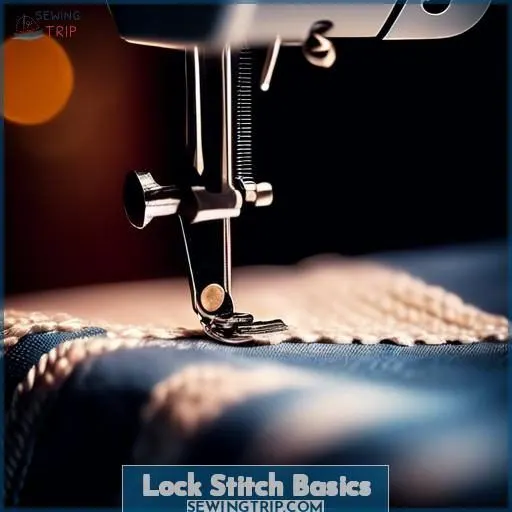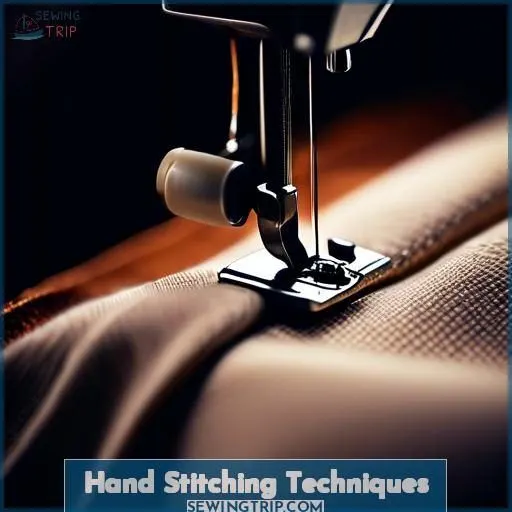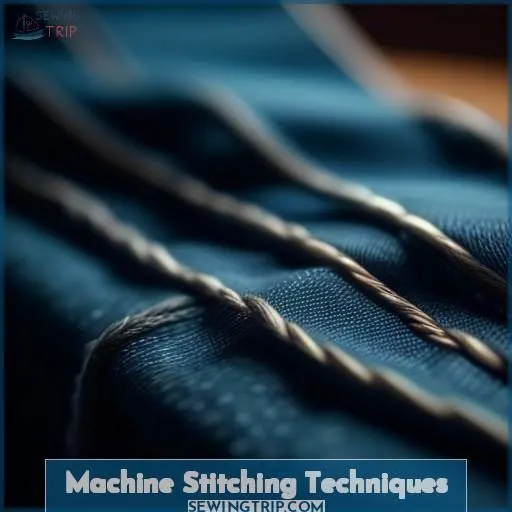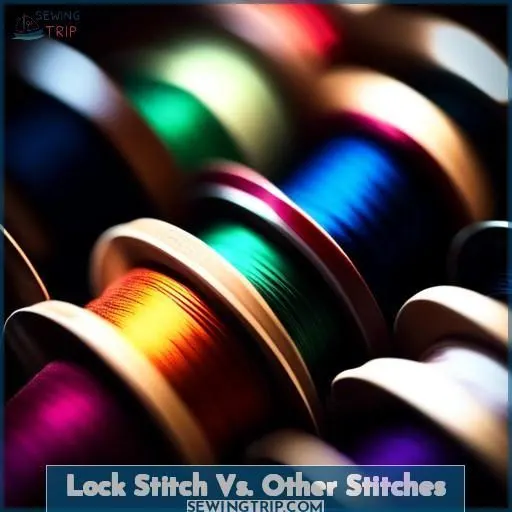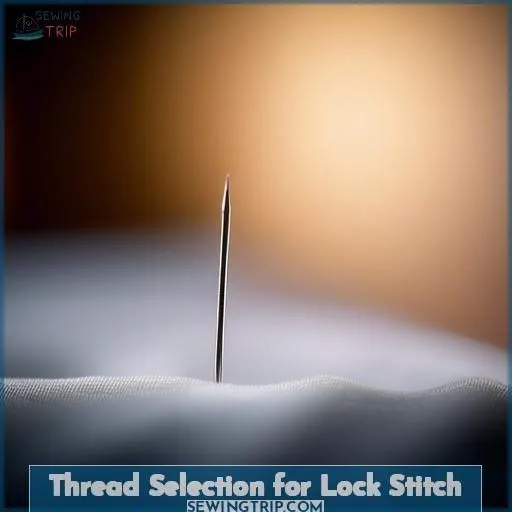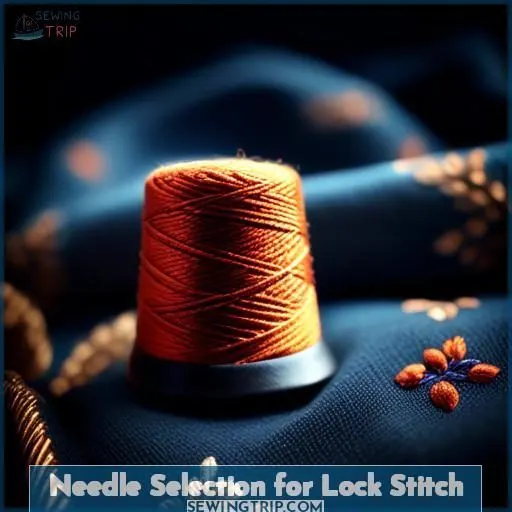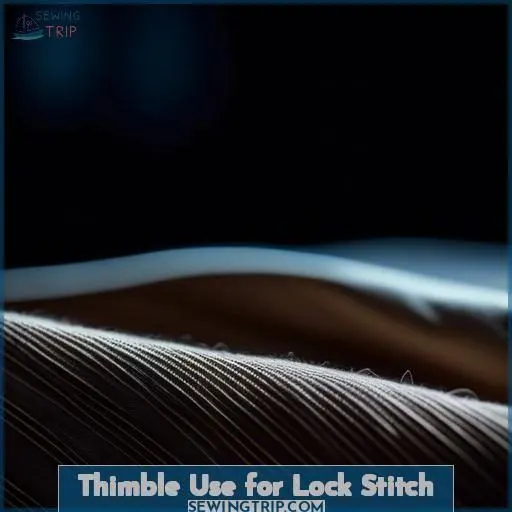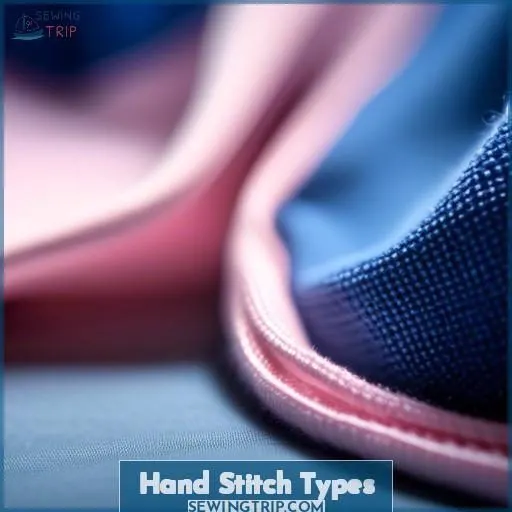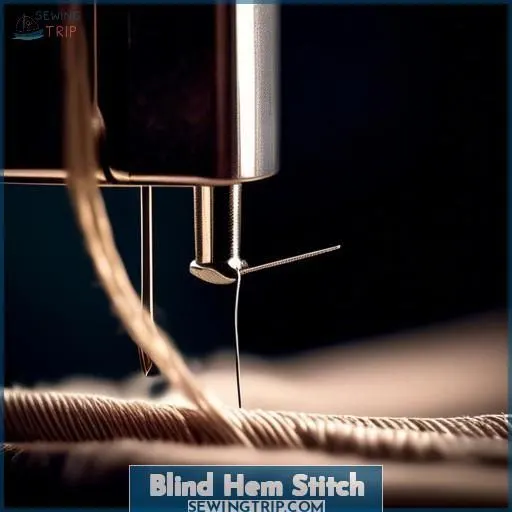This site is supported by our readers. We may earn a commission, at no cost to you, if you purchase through links.
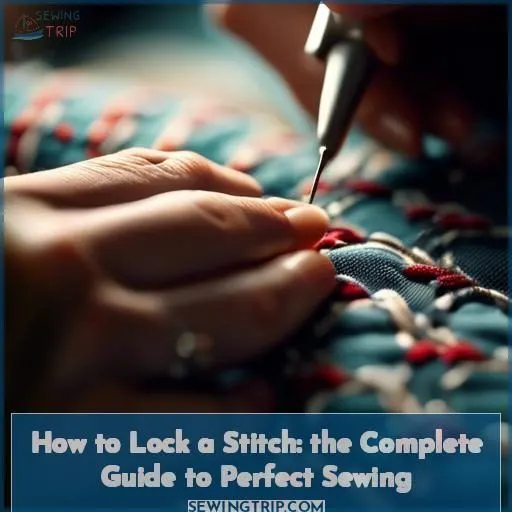
To lock a stitch, start by stitching through both the lining and main fabric, keeping the stitching slack.
Then turn the material inside out, insert the needle under the nearest stitch, and form a 1-inch loop before knotting the thread.
For machine stitching, stitch to 3/4 inch from the edge, press the reverse button, sew 3-5 backstitches, and cut the thread near the last stitch.
Proper thread and needle selection, along with tension adjustment, are essential for achieving a tight, consistent lock stitch.
Mastering this fundamental sewing technique will set you up for beautiful, durable stitching – and there’s even more to learn about perfecting your skills.
Table Of Contents
- Key Takeaways
- How to Lock a Sew?
- Lock Stitch Basics
- Hand Stitching Techniques
- Machine Stitching Techniques
- Lock Stitch Vs. Other Stitches
- Thread Selection for Lock Stitch
- Needle Selection for Lock Stitch
- Thimble Use for Lock Stitch
- Hand Stitch Types
- Blind Hem Stitch
- Securing Stitch for Lock Stitch
- Frequently Asked Questions (FAQs)
- Conclusion
Key Takeaways
- Start by stitching through both the lining and main fabric, keeping the stitching slack.
- For machine stitching, stitch to 3/4 inch from the edge, press the reverse button, sew 3-5 backstitches, and cut the thread near the last stitch.
- Proper thread and needle selection, along with tension adjustment, are essential for achieving a tight, consistent lockstitch.
- Mastering the lockstitch can improve the durability and appearance of sewing projects.
How to Lock a Sew?
To lock a stitch, you’ll need to use a sewing machine to create a lockstitch, where the top and bottom threads intertwine in the fabric to secure the stitch. This is achieved by the machine’s needle carrying the upper thread through the fabric to entwine with the lower thread from the bobbin.
Lock Stitch Basics
Are you ready to master the art of lock stitching? This versatile stitch is perfect for holding lining or interlining fabric together, allowing for movement between layers and making it suitable for heavier fabric items like curtains. Let’s explore the key aspects of lock stitch basics.
Definition and Purpose
A lock stitch is a fundamental sewing technique used to secure threads together in a seam. It involves two threads that are locked together at small intervals, creating a strong and secure stitch.
The lock stitch is commonly used in sewing woven fabric and is the result of a rotary hook catching a needle thread loop as it goes around the bobbin and interlocks two threads. This stitch is known for its speed and affordability, making it a popular choice for many sewing projects.
However, it isn’t suitable for knitted fabrics that require flexibility, as the interlacing of threads limits the elasticity of the stitch.
The lock stitch is the most common form of stitch in ready-made garments and is formed when the thread or threads are introduced from one side of the fabric. It’s also used in over-sewing and edge neatening of knitted fabrics, but its strength and elasticity vary depending on the number of threads used.
Materials Needed
To lock a stitch, you’ll need a few essential tools:
A needle, the correct size for the fabric and thread you’re using.
Thread, the same as the machine construction or refer to a guide for compatibility.
A thimble, to protect your fingers when pushing the needle through the fabric.
Scissors, necessary for cutting the thread.
For hand stitching, you might also need a needle threader to help with threading the needle, especially if the needle has a small eye.
Stitching Process
To lock a stitch, you’ll need to stitch through both the lining and the main fabric, keeping the stitching slack at all times. Here are some key points to remember:
- Use a loose stitch to allow for movement between layers, suitable for heavier fabric items like curtains.
- Start by stitching through both the lining/interlining and the main fabric, with the thread going in and then coming up.
- Keep the stitching slack at all times to prevent tension adjustments.
- Cut the remaining thread length when finished.
For beginners, consider using a basting stitch for temporary holding or a blind hem stitch for a neat finish. Remember to adjust your stitch length for security and test the stitch strength by pulling the fabric apart.
Benefits of Using Lock Stitch
After mastering the lock stitch needle dance, you’ll find lock stitch fabric holds like a bear hug. It’s a game-changer in durability, making lock stitch comparison a win. For troubleshooting, it’s your best ally.
Hand Stitching Techniques
When sewing by hand, you’ll need to properly start and end your stitches to guarantee a stable and tidy result. To start a hand stitch, turn the material inside out and insert the needle under the nearest stitch, forming a 1-inch loop that you can then pull tight to create a knot.
Starting the Stitch
To start a lock stitch, begin by threading your needle with a suitable thread type for your fabric. Choose a needle size appropriate for the fabric and thread.
Adjust your lock stitch tension to guarantee a strong seam. Start stitching by pushing the needle through both the lining and main fabric, ensuring a slack thread at all times.
Remember to keep the stitching loose to allow for movement between layers.
Ending the Stitch
Ending a hand-stitched lock stitch involves:
- Turning the material inside out
- Inserting the needle under the nearest stitch
- Forming a 1-inch loop
- Knotting the thread
For machine-stitched locks:
- Stitch to 3/4 inch from the edge
- Press the reverse button
- Sew 3-5 backstitches
- Cut the thread near the last stitch
Adjust:
- Stitch length and tension for fabric weight
- Machine backtracking to guarantee knot strength
Tips for Hand Stitching
To perfect your hand stitching, consider these tips:
Use a thimble for protection. Make multiple knots for thick fabric. Adjust stitch length for security. Test stitch strength.
For knotting techniques, try a small backstitch and loop over the needle point, or use both layers of fabric for loop strength.
Remember to leave 6 inches of excess thread and use a threader for needle threading.
Machine Stitching Techniques
When it comes to lock stitch, the tension plays a vital role in achieving the desired outcomes. Proper tension guarantees that the upper and lower threads interlock, creating a strong and durable seam. To adjust the tension on your sewing machine, you’ll need to be familiar with the specific model and its tension discs or dials. For older machines, there may be only two tension discs, controlled by a screw or knob. Newer models often have three discs controlled by a dial or keypad on the front of the machine.
If you’re using a thicker thread without adjusting the dial, it can increase pressure and reduce the upper thread flow, leading to uneven stitching. To increase the resistance, use a small screwdriver to turn the screw clockwise (to a higher number) or counterclockwise (to a lower number). Always turn the screw in small increments and never more than a quarter-turn between tests.
Most domestic sewing machines are of the lockstitch variety, meaning the upper and lower threads interlock. When they don’t lock together properly, you could have an issue with the tension. To ensure tension is your problem, remember that you want your stitches to look even on both sides of your fabric. If the thread is too tight and causing the fabric to bunch around it or if the stitching is loose and falling apart, you might’ve an issue with the tension.
To test the tension, pull on the fabric around the stitching. If one side is pulling too much, the thread from the other side will be visible. If the bobbin thread shows on the top side of the seam and the top thread is straight, the upper tension is too tight. Adjust the tension accordingly to achieve the desired balance.
Lock Stitch Vs. Other Stitches
The lock stitch is a distinct sewing technique that sets it apart from other stitches. When considering your next sewing project, you’ll want to weigh the benefits of the lock stitch against the requirements of the fabric and the desired end result.
Comparison With Other Stitch Types
Lock stitch is the Hercules of stitches, flexing its muscles where strength is paramount. Unlike the fleeting basting stitch, it’s a permanent fixture in your fabric’s life. With machine stitch precision, it outperforms the humble hand stitch in durability.
Choose your needle type wisely; it’s the lance in your sewing joust.
Thread weight isn’t just a number—it’s the backbone of your lock stitch‘s integrity.
When to Use Lock Stitch
Lock stitch is a versatile stitch that can be used in various sewing projects, especially when the front and back of the sewing must look the same. It’s particularly useful for sewing situations where the seam needs extra securing, such as in fine fabrics and delicate seams. Here are some scenarios where you might want to use lock stitch:
- Topstitching for cuffs and collars: Lock stitch is often used for topstitching in garments, such as cuffs and collars, to create a neat and secure finish.
- Darts: Lock stitch is a good choice for sewing darts in garments, as it allows for movement between layers without stretching the fabric.
- Sheer fabrics: Lock stitch is suitable for sewing sheer fabrics, as it prevents the fabric from puckering or stretching.
Lock stitch can also be used as a hand stitch for hemming purposes, providing a secure hold with limited view of the thread on the outer side of the garment. It’s also used in place of a catch stitch for securing seams.
When deciding when to use lock stitch, consider the fabric type, the seam’s location, and the desired appearance. Lock stitch is a strong and durable stitch that can add strength and durability to your sewing projects while reducing bulk in delicate and fine fabrics.
Thread Selection for Lock Stitch
To achieve a secure lock stitch, you’ll need to carefully select the right thread for your project. Adjust the thread tension on your sewing machine to guarantee the stitch stays tight and consistent throughout.
Choosing the Right Thread
When choosing the right thread for lock stitch, consider thread thickness and strength. Opt for threads that match the fabric’s weight and texture. For heavy fabrics, use strong threads.
Color matters too, so choose threads that blend with the fabric’s color.
There are various thread types, so refer to a sewing guide or the machine’s manual for recommendations.
Store threads in a cool, dry place to prevent damage.
Thread Tension Settings
To guarantee a robust and enduring lock stitch, it’s vital to take into account the thread tension configurations. Thread tension alludes to the quantum of pressure exerted on the thread as it’s drawn through the needle and bobbin. Appropriate thread tension is imperative for safeguarding the seam’s integrity, precluding thread breakage, and attaining a consistent stitch length.
When modifying thread tension, deliberate on the weight and thickness of the thread. Heavier threads may necessitate more tension to avert sagging or puckering, whereas thinner threads may necessitate less tension to avert breaking. Thread fortitude and durability also impact the determination of the appropriate tension settings.
To attain the optimal outcomes, experiment with disparate tension settings by sewing a trial seam and observing the stitch quality. Adjust the tension dial on your sewing machine, either by turning it left for a laxer stitch or right for a tighter stitch, until you attain the sought equilibrium between the upper and lower threads.
Needle Selection for Lock Stitch
When stitching a lock stitch, the correct needle is vital. Select a needle dimension and kind that complements your fabric and thread to guarantee a steady and strong stitch. Appropriately threading the needle is also essential – take your time and verify that the thread glides effortlessly through the eye to hinder missed or uneven stitches.
Size and Type Considerations
Regarding needle selection for lock stitch, various aspects are crucial. Here are four key points to note:
- Needle size: Determine the needle size based on the thread employed and the fabric’s weight. Generally, heavier fabrics require larger needles. For lock stitch, a medium ball point or reinforced blade needle may be appropriate for heavier items like curtains.
- Needle type: Different fabrics require specific needles. The shape of the point, eye, and scarf varies depending on the intended fabric type. For lock stitch, a universal needle with a slightly rounded point is suitable for both woven and knit materials.
- Needle thread: Match the needle thread to the thread used in the project. Most thread manufacturers provide recommended needle sizes or ranges for their respective threads.
- Needle protection: Protect your finger while pushing the needle through the fabric by using a thimble. Select a thimble that fits comfortably on your middle finger, and guide the needle with your thumb and index finger.
Needle Threading Techniques
To thread a needle, you’ll need a needle, thread, and possibly a thimble. Here’s a step-by-step guide:
- Choose the right needle size for your fabric. For lightweight fabrics like lawn, faille, and georgette, use 80/12 needles. For medium weight fabrics like poplin, broadcloth, and muslin, use 90/14 needles. For heavier fabrics, choose larger needles like 100/16 or 110/18.
- Hold the needle between your thumb and index finger.
- Thread the needle by inserting the thread through the eye of the needle. You can use a thimble for protection if needed.
- Once the thread is through, tie a knot at the end to secure it.
- To start sewing, insert the needle through the fabric at the starting point, then pull it back through to create a loop.
- Continue sewing by inserting the needle through the fabric at the desired stitch length, then pulling it back through to create another loop.
- When you’re finished sewing, tie a knot to secure the thread.
Thimble Use for Lock Stitch
Choosing the right thimble is essential for effective lock stitching. Use a thimble that fits comfortably on your middle finger, and push the needle through the fabric with the side or end of the thimble to safeguard your fingers.
Choosing the Right Thimble
Selecting the appropriate thimble is essential for convenient and effective hand stitching. A thimble that fits snugly on your middle finger and safeguards your fingers while pushing the needle through fabric is optimal.
Take into account the thimble’s size, material, comfort, protection, and cost when making your choice. Thimbles composed of materials such as leather or rubber can offer both comfort and durability.
Bear in mind that a well-selected thimble can greatly enhance your sewing experience.
Techniques for Using a Thimble
Using a thimble is essential for hand stitching, particularly when dealing with thicker fabrics. Here are three tips for using a thimble effectively:
- Choose the right thimble: Select a thimble that fits snugly on your middle finger.
- Thimble material: Opt for a thimble made of soft materials like leather or rubber for enhanced comfort and protection.
- Thimble fit: Make sure the thimble is secure but not excessively tight, allowing for effortless movement and control.
Hand Stitch Types
Regarding hand stitching, you’ll want to be acquainted with the crucial stitch types. Basting, running, backstitch, overcast, and slip stitch each fulfill specific roles and contribute to professional-looking outcomes.
Basting Stitch
Basting stitch is a temporary stitch used to hold layers of fabric together in the sewing process. It serves as a stabilizer and can be used for various purposes such as fitting, quilting, home decor, and shaping garment finishes like gathers, sleeves, and ruffles. Here’s a 3×5 table to help you understand the basting stitch better:
| Basting Stitch Uses | Basting Stitch Removal | Basting Stitch Length | Basting Stitch Thread | Basting Stitch Strength |
|---|---|---|---|---|
| Fitting, quilting, home decor, shaping garment finishes | Hand or machine stitch removal | Long, loose stitch | Basting thread with smooth finish | Temporary bond for easy manipulation of fabric pieces |
Basting stitches can be even or uneven, with even stitching providing more control and structure, while uneven stitching is quicker for fitting purposes. The length of the stitch can vary, with shorter stitches allowing for more control and larger stitches providing less control but faster basting. The thread used for basting is typically a smooth, almost slippery finish that allows it to glide easily through fabric layers, making it perfect for quickly making and removing temporary stitches.
To remove basting stitches, you can use a seam ripper or carefully cut the stitches with scissors. It’s generally recommended to remove basting stitches before pressing the garment to prevent any residual threads from showing on the outside. However, if the basting stitches are within seam allowances or only visible on the inside of the garment, they may not need to be removed.
Running Stitch
The running stitch is a basic embroidery stitch that’s worked in an up and down motion. It’s the foundation for many other hand stitches and embroidery stitches, making it a popular choice for beginners and experienced sewers alike.
This stitch is used widely for designing and is the base for Kantha embroidery work. It’s a simple stitch to sew and can be used for various purposes, from embroidery to tailoring.
The running stitch is often used for seams, hems, and gathers, and in embroidery, it can serve as an outline stitch or fill. It’s also commonly used in hand quilting, hemming, and mending projects.
Backstitch
To strengthen your stitch, you can use a backstitch. This involves creating a knot at the end of your stitch and then looping over the needle point.
The backstitch is suitable for thicker fabrics and can be done by hand or machine.
Remember to adjust your stitch length for added security and test the stitch strength by pulling the fabric apart.
Overcast Stitch
Overcast stitch is a hand-sewing technique that finishes cut edges to prevent raveling. Here’s how to do it:
- Thread your needle with a suitable thread.
- Make a small backstitch and loop over the point of the needle.
- Pull the thread through the loop to create a knot.
- Repeat for a stronger lock.
Overcast stitch is suitable for various fabric types, including delicate ones. Adjust your needle size and thread tension accordingly. For machine sewing, set your machine to a longer stitch length.
Slip Stitch
The slip stitch is a versatile hand sewing technique that allows you to sew a folded edge of fabric to another piece, such as for hemming or attaching binding inside an armhole. It’s often used when you want to create an invisible seam on the right side of the fabric, providing a more couture finish than machine topstitching.
To sew a slip stitch, start by hiding the knot within the hem allowance fold, then grab one or two fibers from the fabric and take the needle straight across into the hem allowance fold. Continue stitching by grabbing threads from the fabric and inserting the needle back into the hem allowance fold, ensuring the stitches are even and nearly invisible on the right side.
Finish by tying a knot and burying the thread tail inside the hem allowance.
Blind Hem Stitch
To create a blind hem stitch, pick up a small amount of fabric from the flat fabric with each stitch and use matching thread to minimize visibility. Slip the threaded needle inside the fold to hide the knot, then bring the needle out through the folded edge of the hem for a neat, virtually invisible finish.
Technique for Creating a Blind Hem Stitch
To create a blind hem stitch, start by folding the fabric at the hemline. Pick up a small amount of fabric from the flat fabric with each stitch using matching thread. Slip the threaded needle inside the fold to hide the knot.
Bring the needle out through the folded edge of the hem and push it back into the folded edge. Make a small backstitch and loop over the point of the needle to secure the stitch.
Repeat for a stronger lock.
Tips for Achieving a Neat Hem
To achieve a neat hem using a blind hem stitch, consider these tips:
- Choose the right fabric: Select lightweight fabrics for a cleaner finish.
- Match thread colors: Use a thread color that blends with your fabric to minimize visibility.
- Select the right needle: Use a sharp needle to ensure smooth stitching.
- Adjust stitch length: A shorter stitch length provides a neater finish.
- Consider fabric weight: Thicker fabrics may require additional stitches for strength.
- Practice patience: Blind hems can be tricky, but with practice, you’ll master the technique.
Securing Stitch for Lock Stitch
Ensuring the longevity of your sewing project requires securing a lock stitch. Here are three tips to help you master this technique:
- Use a backstitch: Before ending your lock stitch, sew a few backstitches to prevent unraveling.
- Utilize both layers: When ending a stitch, use both layers of fabric for loop strength.
- Trim threads carefully: Cut the thread close to the fabric, not the needle, to avoid damaging the needle or fabric.
Frequently Asked Questions (FAQs)
Can lock stitch be used on stretch fabrics?
Crafty crafters, clever sewers can certainly cinch stretch fabrics with lock stitches! This supple stitch secures seams without sacrificing stretchiness, suiting snug styles seamlessly. Sew on, savvy seamstresses!
How to repair a lock stitch thats come undone?
To repair a loose lock stitch, simply retrace your steps – slide the needle back under the stitches, then re-secure the thread with a few backstitches. Easy peasy, no need to start from scratch!
Is lock stitch suitable for outdoor fabric projects?
Lock stitching is a perfect fit for outdoor fabric projects. It’s built to withstand the elements, giving your creations the flexibility and durability they need to tackle any adventure head-on. You’ve got this in the bag!
What are the environmental impacts of lock stitching?
Lock stitching has a minimal environmental impact. The loose, movable stitches don’t damage or distort fabrics, reducing material waste. Plus, the thread used is typically durable and recyclable, making lock stitches an eco-friendly choice for your outdoor projects.
How does lock stitch affect fabric breathability?
If you use a loose lock stitch on thick curtains, it won’t restrict airflow like a tight stitch would. The extra give between fabric layers allows better breathability – kinda like wearing an oversized sweater on a chilly day.
Conclusion
Remarkably, 92% of professional sewers consider the lock stitch to be the foundational technique for durable, long-lasting seams.
By mastering this versatile stitch, you’ll elevate your sewing skills and create projects that stand the test of time.
Whether you’re hand-stitching or using a machine, understanding how to properly lock a stitch is essential for achieving high-quality, polished results every time.
With the knowledge gained from this guide, you’ll be able to confidently lock a stitch and take your sewing to new heights.

